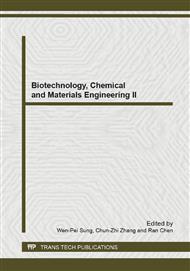p.886
p.890
p.894
p.898
p.902
p.906
p.910
p.915
p.919
Salt Tolerance of Four Biodiesel Plant Species on Germination
Abstract:
Due to increasing salinity problems and biodiesel production, in this experiment four vegetables species were treated with different concentration of NaCl solution and the growth values were evaluated on germination to be able to understand salinity tolerance of main biodiesel plant species and screen better species which is possible to be cultivated on salinity land. Results indicated that salinity caused significant reduction in germination vigor (GV), relative percentage of germination (RGP), relative radicle length (RRL). Under higher salt concentration (9g/L), GV of soybean was lowest; GV of camelina and rape was highest. Soybean was sensitive to salinity stress under 3-6g/L according to relative percentage of germination (RGP). Under conditions of the higher salt stress (9g/L), RGP of rape and camelina was higher than oil sunflower and soybean. When saline concentration was 6g/L, the differentiation of RRL was more remarkable between species and rape had highest RRL (33.5%), next was camelina (26.5%), soybean (20%) and RRL of oil sunflower was lowest (12.4%). RRL of four species was less than 11-14% and RRL of camelina was higher than others when saline concentration increased into 9-12 g/L. All species had not any growth under salt concentration of 15g/L. Camelina had higher concentration of salinity tolerance (CST, 6g/L) than other three species, the rest was 2-3g/L. Camelina and rape had higher half lethal concentration (HLC, 9g/L), next was soybean (6g/L), and lowest one was oil sunflower (3g/L). Salt tolerance ranking for the four species based CST and HLC was camelina > rape > soybean > oil sunflower. It is possible for camelina to grow in saline soil in North of China after its suitable cultivation system is established.
Info:
Periodical:
Pages:
902-905
Citation:
Online since:
January 2013
Authors:
Price:
Сopyright:
© 2013 Trans Tech Publications Ltd. All Rights Reserved
Share:
Citation:


